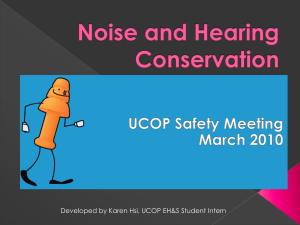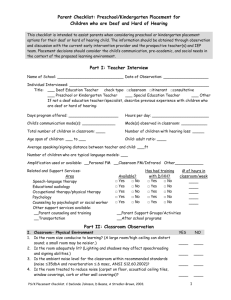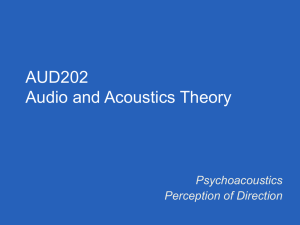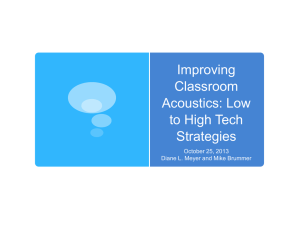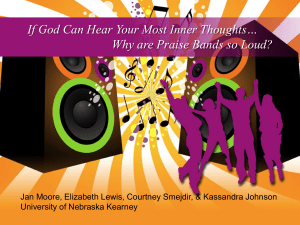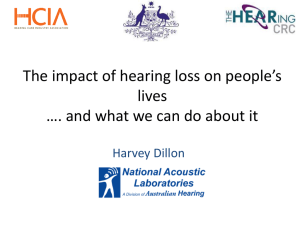noise exposure and hearing conservation - Linn
advertisement
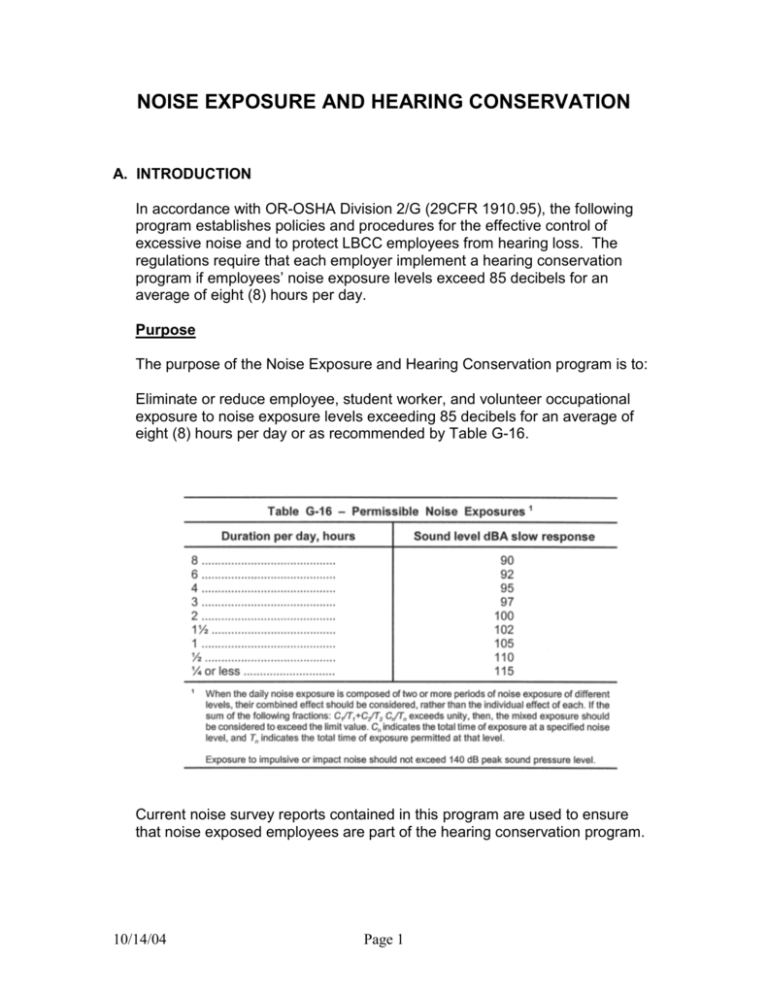
NOISE EXPOSURE AND HEARING CONSERVATION A. INTRODUCTION In accordance with OR-OSHA Division 2/G (29CFR 1910.95), the following program establishes policies and procedures for the effective control of excessive noise and to protect LBCC employees from hearing loss. The regulations require that each employer implement a hearing conservation program if employees’ noise exposure levels exceed 85 decibels for an average of eight (8) hours per day. Purpose The purpose of the Noise Exposure and Hearing Conservation program is to: Eliminate or reduce employee, student worker, and volunteer occupational exposure to noise exposure levels exceeding 85 decibels for an average of eight (8) hours per day or as recommended by Table G-16. Current noise survey reports contained in this program are used to ensure that noise exposed employees are part of the hearing conservation program. 10/14/04 Page 1 Scope This plan covers all employees, student workers, and volunteers who work in areas with excessive noise levels. Employees who work more than 4 hours per day in an area with noise levels exceeding 85 dBA will be required to have regular hearing tests. The primary affected employees are college staff who occasionally work with loud equipment or in areas of possible high noise: Maintenance, Grounds, and Welding. All employees, student workers, students and volunteers are required to comply with the scope of this Noise Exposure & Hearing Conservation plan. B. DEFINITIONS Permissible Noise Exposure: There are two exposure levels that if exceeded require specific compliance activities: Permissible Noise Exposure is an eight hour time-weighted average of 90 decibels on the A scale or a dose of 100%. Action Level is an eight hour time-weighted average of 85 decibels on the A scale or a dose of 50%. Representative Noise Exposure: Measurements of an employee’s noise dose or 8 hour time-weighted average sound level that the college deems to be representative of the exposures of other employees in the workplace. Sound measurements as taken by: (Name of person conducting the survey, date of survey, type of instrument.) Noise dosimeter: An instrument that integrates a function of sound pressure over a period of time in such a manner that it directly indicates a noise dose. Sound level meter: An instrument for the measurement of sound level. Time-weighted average sound level: That sound level which, if constant over an 8-hour exposure, would result in the same noise dose as is measured. 10/14/04 Page 2 C. GENERAL RESPONSIBILITIES Safety & Loss Prevention Manager is responsible for the following: General oversight of the program Provide regular evaluation of the program. Work with Division Deans and Center Directors, and/or area supervisors to ensure the program is implemented in every appropriate program or activity Ensure representative noise surveys are conducted Ensure employees are trained on the use of hearing protection Train supervisors on the use of hearing protection Maintain records of noise surveys Serve as the college’s Program Administrator Maintain the Noise and Hearing Conservation written program Perform evaluations of the program. Hearing Control Officer (Assistant Director, Human Resources) is responsible for the following: Notify employees and supervisors of shifts in hearing Ensure that employee medical records and all past employee records per the OSHA standard are maintained Assist Safety & Loss Prevention Manager with evaluation of the program. Supervisors are responsible for the following: Ensure that noise exposed employees wear hearing protection Ensure that noise exposed employees receive annual noise training Ensure that noise exposed employees have baseline and annual hearing tests Serve as the department’s Program Administrator Assist Safety & Loss Prevention Manager with evaluation of the program. All Noise Exposed Employees, Student Workers, Students and Volunteers are responsible for the following: Be familiar with the NE&HC program Wear appropriate hearing protection Take an active part in the annual training Have baseline and annual hearing tests. Directors, Division Deans, and Center Directors, or their designees, are responsible for the following: Ensure the Noise Exposure and Hearing Conservation Program is implemented 10/14/04 Page 3 Ensure affected staff, students, and volunteers are trained in the use of hearing protection Serve as the Division’s or Center’s Program Administrator Maintain training records for participating staff, students, and volunteers Inform Safety & Loss Prevention Manager of names and contact information of “Designees” Assist Safety & Loss Prevention Manager with evaluation of the program. D. NOISE SURVEYS Noise surveys are required to be done on work operations that have potentially high noise levels (85 dBA and above). The noise measurements will be included in the program manual. Additional noise surveys are required to be taken when additional equipment or processes are introduced which could result in higher noise levels, and periodically to re-verify the test results. Assistance with noise monitoring can be obtained from the college’s workers’ compensation insurance carrier, OR-OSHA consultants, or through outside consultants. The noise survey measurements are recorded on the employees hearing test records. Each employee exposed to noise at or above the 85 dBA average is to be informed of the results. This will be done by posting the data and including the information at the employee initial and annual employee noise training. E. HEARING PROTECTION Hearing protection is required to be worn during the operation of equipment or processes that exceed 85 dBA noise levels as a time-weighted average exposure. The hearing protection required or recommended by area (ear plugs, foam plugs, or ear muffs) are available in the following areas: Grounds – Landscape Maintenance Maintenance – Maintenance Shop Welding – Welding Lab 10/14/04 Page 4 The use and availability of the hearing protection will be pointed out to each new employee during their initial safety orientation. EMPLOYEES REQUIRED TO WEAR HEARING PROTECTION WILL BE INFORMED BY THEIR SUPERVISOR Employees will be trained in how to properly fit the hearing protectors by their supervisor or with assistance from outside safety/health consultants. If anyone has problems with the devices, please contact your supervisor. Employees will be provided with at least two styles of protection – plugs or muffs to try on to determine which device would be best for them. All the devices provided will be evaluated to determine if they provid adequate noise attenuation for the noise exposure levels. Each employee will be responsible for the maintenance of his/her assigned hearing protective devices. Disposable plugs will be discarded at end of shift or when they become excessively soiled. Inserts or barriers will be checked prior to each use for any defects. If barriers are used, the head band will be checked to ensure it is tight and the inserts are not torn, disfigured, or do not properly seal. If equipment is damaged, new devices will be obtained and used. Manufacturer’s recommendations on maintenance will be followed. F. AUDIOMETRIC (HEARING) TESTING New employees assigned to a noise area (where the time weighted exposure to noise is above 85 dBA) will be given a baseline hearing test and then will be tested annually thereafter. The hearing test will be given by contracted certified audiometric technicians. Hearing tests showing a significant hearing loss are forwarded to the contracted professional reviewer. Baseline or initial tests will be given to new employees at the time of hire, or within 6 months of an employee’s first exposure at or above the action level. The baseline tests require the employee not to be in the occupational noise area for 14 hours prior to the test. The test will be conducted at the start of the work shift. This test will be the reference for further tests to determine if hearing levels change. Annual hearing test should be taken at the start of a work shift. These results will be compared with the baseline tests. 10/14/04 Significant threshold shift (STS) criterion: The hearing loss criterion is a change in hearing threshold relative to the baseline audiogram of an Page 5 average of 10 dB or more at 2000, 3000, and 4000 hertz (Hz) in either ear. The employee may be retested within 30 days and the results of the retest will be considered to determine if a permanent shift has occurred. Employees will be informed if their tests show significant changes in their hearing levels based on OR-OSHA standards. Within 21 days of receiving notification from the contracted audiologist of the employee’s hearing change, the Hearing Control Officer will notify the employee in writing of the determination and follow-up by the college. In all cases of hearing loss, the employee will be re-instructed on how to properly wear hearing protection. The supervisor and/or the Safety & Loss Prevention Manager will follow-up on all hearing tests that show a reduction in the employee’s hearing from the baseline. (SEE NOTIFICATION FORM) The contracted audiologist will determine if additional tests are needed and the status of the employee’s hearing. LBCC has contracts with Mid-Valley Speech & Hearing Center and Corvallis Clinic Occupational Medicine to provide this service. The LBCC supervisor must contact the Hearing Control Officer, in Human Resources before the employee may call to make the appointment. Baseline and annual hearing tests are a departmental expense. Note: Job descriptions need to be available to the contracted audiologist at the time of hearing testing, as well as information about duration and frequency of noise exposure, and hearing protection provided. G. EMPLOYEE TRAINING New employees will receive Hearing Conservation training at initial assignment to a noise area. The training will be repeated annually for all noise exposed employees. The specific training materials are provided in this manual and are to be a guideline for college supervisors and/or safety committee representatives to use. A copy of the training materials will be available to employees by contacting his/her supervisor or the Safety & Loss Prevention Manager. 10/14/04 Page 6 Training shall include the following topics: Effects of noise on hearing Hearing protectors’ purpose, advantages and disadvantages, attenuation of various types, and instructions on selection, fitting, use and care Purpose of hearing testing and an explanation of the test procedures. A copy of the OR-OSHA Noise & Hearing Conservation Rules is posted on the Safety & Loss Prevention web site at http://www.linnbenton.edu/go/safetyand-loss-prevention/safety-plan. H. NOISE ENGINEERING CONTROLS The Safety & Loss Prevention Manager is responsible to determine if there are feasible engineering controls that could reduce noise levels to below 85 dBA as a time-weighted 8-hour average. Engineering Control Feasibility Studies: In some cases there may be records of noise control studies done on pieces of equipment or processes. These records should be kept to show compliance with OR-OSHA noise engineering control standard. The records should be maintained for the duration the equipment or process is in use. I. RECORDKEEPING Records must be maintained for the various elements of the program. This includes the following requirements: Noise Exposure Measurement Time Frame: Current plus 2 years of results. (Note: The current record may represent measurements taken longer than 2 years ago. This is permitted as long as the readings are reflective of noise exposure levels.) Audiogram records Time Frame: Duration of employment plus thirty years. Training Records Time Frame: Employee training records will be kept on file by their supervisor and available for employee inspection upon request. Training record shall be maintained for three years from date of the training. 10/14/04 Page 7 The following information shall be documented: 1. The dates of the training sessions; 2. An outline describing the material presented; 3. The names and qualifications of the person conducting the training; and 4. The names and job titles of all persons attending the training sessions. Access to records All records required by this Hearing Conservation program shall be provided upon request to employees, former employees, and individual employee representatives, and to the Assistant Secretary of Labor for the Occupational Safety and Health Administration and the Director of the National Institute for Occupational Safety and Health upon request. The provisions of 29 CFR 1910.20 (a)-(e) and (g)-(i) apply to access to records under this section. If LBCC is closed and there is no successor employer to receive and retain records for the described period, the Director of National Institute of Occupational Safety and Health (NIOSH) shall be contacted for final disposition. OSHA 300 Log Record If an employee’s hearing shift is permanent it must be recorded on the employer’s OSHA 300 Log. (By definition, a standard threshold shift is identified as a 10dB shift at 2000, 3000, and 4000 Hz.) Employee must be informed in writing within 21 days of the determination of permanent hearing shift. The Assistant Director, Human Resources is responsible for OSHA 300 Injury and Illness Log. 10/14/04 Page 8

